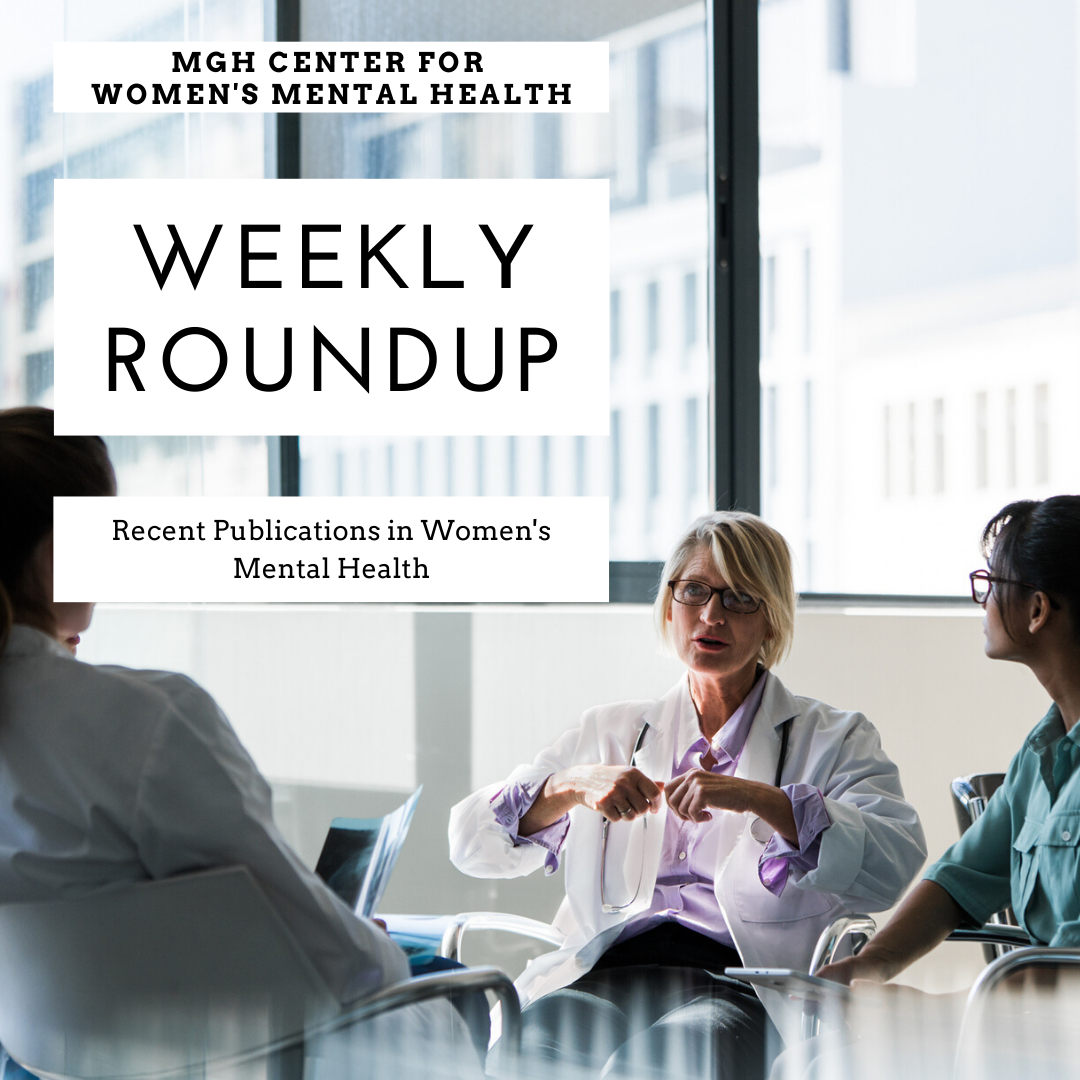
Every week we review the most recent publications in women’s mental health, covering topics related to premenstrual symptoms, perinatal mood and anxiety disorders, use of medications in pregnant and breastfeeding women, perinatal substance use, and menopausal mental health.
For more detailed descriptions of many of these topics, you can sign up to receive our weekly CWMH NEWSLETTER which comes out every Thursday.
And don’t forget to visit ESSENTIAL READS – a curated selection of up-to-date and clinically relevant articles in women’s mental health.
Ruta Nonacs, MD PhD
PMS AND PMDD |
| No articles this week
|
INFERTILITY AND MENTAL HEALTH |
| Effect of cognitive behavioral therapy-based counseling on perceived stress in pregnant women with history of primary infertility: a controlled randomized clinical trial.
Golshani F, Hasanpour S, Mirghafourvand M, Esmaeilpour K. BMC Psychiatry. 2021 May 31;21(1):278. Free article. After the intervention, the mean scores of perceived stress (mean difference: – 7.3; CI 95%: – 0.9 to – 5.6; p < 0.001) and anxiety (mean difference:-14.7; CI 95%.- 20.6 to – 8.8; p < 0.001) were significantly lower in the intervention group. The mean depression score in the intervention group was also lower than the control; however, this finding was not statistically significant.
|
PSYCHIATRIC ILLNESS DURING PREGNANCY |
| Is there an increased risk of perinatal mental disorder in women with gestational diabetes? A systematic review and meta-analysis.
Wilson CA, Newham J, Rankin J, Ismail K, Simonoff E, Reynolds RM, Stoll N, Howard LM. Diabet Med. 2020 Apr;37(4):602-622. Free article. There was an increased risk of depressive symptoms in the antenatal period around the time of diagnosis of GDM [odds ratio (OR) 2.08; 95% CI 1.42, 3.05] and in the postnatal period (OR 1.59; 95% CI 1.26, 2.00).
Singla DR, MacKinnon DP, Fuhr DC, Sikander S, Rahman A, Patel V. Br J Psychiatry. 2021 Mar;218(3):143-150. Thinking Healthy Programme Peer-delivered (THPP) is an evidence-based psychosocial intervention for perinatal depression. Branquinho M, Rodriguez-Muñoz MF, Maia BR, Marques M, Matos M, Osma J, Moreno-Peral P, Conejo-Cerón S, Fonseca A, Vousoura E. J Affect Disord. 2021 May 13;291:294-306 CBT is currently the most evidence-based psychological intervention, provided in different delivery formats (individual, group, face-to-face or Internet-based).
|
MEDICATIONS AND PREGNANCY |
| No articles this week
|
POSTPARTUM PSYCHIATRIC ILLNESS |
| Mums Alone: Exploring the Role of Isolation and Loneliness in the Narratives of Women Diagnosed with Perinatal Depression.
Taylor BL, Howard LM, Jackson K, Johnson S, Mantovani N, Nath S, Sokolova AY, Sweeney A. J Clin Med. 2021 May 24;10(11):2271. Free article. Women often connected feelings of depression during and after pregnancy to feeling dislocated from their previous identities and relationships. Women felt lost, confined to their homes, and often unsupported by their partners and families. However, fears of being judged to be inadequate mothers made it difficult for women to make authentic connections with others or to express negative feelings, increasing isolation and depression. Bryson H, Perlen S, Price A, Mensah F, Gold L, Dakin P, Goldfeld S.Arch Womens Ment Health. 2021 May 2. In a cohort of mothers experiencing adversity, depression, anxiety, and stress symptoms were highest in pregnancy and at 4 to 5 years postpartum. Traumatic memories of childbirth relate to maternal postpartum posttraumatic stress disorder. Thiel F, Berman Z, Dishy GA, Chan SJ, Seth H, Tokala M, Pitman RK, Dekel S. J Anxiety Disord. 2021 Jan;77:102342. Women endorsing childbirth associated PTSD symptoms on the PTSD-Checklist (PCL)-5 reported more incoherent childbirth memories with more emotional and sensory details, and more frequent involuntary recall and reliving of the memory.
|
MEDICATIONS AND BREASTFEEDING |
| No articles this week
|
PERINATAL SUBSTANCE USE |
| Prenatal Substance Exposure and Developmental Trajectories of Internalizing Symptoms: Toddlerhood to Preadolescence.
Min MO, Albert JM, Lorincz-Comi N, Minnes S, Lester B, Momotaz H, Powers G, Yoon D, Singer LT. Drug Alcohol Depend. 2021 Jan 1;218:108411. Gender-separate group-based trajectory modeling yielded five distinctive developmental trajectories of internalizing symptoms from ages 2 to 13 in both boys and girls: low-risk group (14.4% girls, 28.8% boys); normative-decreasing group (35.3% girls, 33.1% boys); increasing risk group (14.4% girls, 13.0% boys); early-high group (22.3% girls, 17.9% boys); and chronic group (13.8% girls, 7.2% boys). Prenatal tobacco exposure, maternal psychological distress, and postnatal maternal alcohol use differentiated the longitudinal courses of internalizing symptoms. Boys were more likely to follow the low-risk trajectory, whereas girls were more likely to follow the chronic trajectory.
|
MATERNAL MENTAL HEALTH AND CHILD OUTCOMES |
| Maternal depression during pregnancy alters infant subcortical and midbrain volumes.
Sethna V, Siew J, Gudbrandsen M, Pote I, Wang S, Daly E, Deprez M, Pariante CM, Seneviratne G, Murphy DGM, Craig MC, McAlonan G. J Affect Disord. 2021 May 14;291:163-170. Free article. Compared with infants of non-depressed mothers, infants exposed to maternal antenatal depression had significantly larger subcortical grey matter volumes and smaller midbrain volumes. There was no association between medication exposure during pregnancy and the infant regional brain volumes examined in our sample. Norcross PL, Bailes LG, Leerkes E. Infant Behav Dev. 2020 Nov;61:101498. Socioeconomic risk and depressive symptoms interacted such that depressive symptoms, both during pregnancy and postpartum, predicted lower sensitivity among mothers at heightened socioeconomic risk. Maternal perinatal depression and child executive function: A systematic review and meta-analysis. Power J, van IJzendoorn M, Lewis AJ, Chen W, Galbally M. J Affect Disord. 2021 May 14;291:218-234. This meta-analysis identified a small, statistically significant relationship between perinatal depression and child executive function (effect size r = 0.07; 95% CI 0.03-0.10).
|
MENOPAUSE AND MENTAL HEALTH |
| Lowered progesterone metabolite excretion and a variable LH excretion pattern are associated with vasomotor symptoms but not negative mood in the early perimenopausal transition: Study of Women’s Health Across the Nation.
McConnell DS, Crawford SL, Gee NA, Bromberger JT, Kazlauskaite R, Avis NE, Crandall CJ, Joffe H, Kravitz HM, Derby CA, Gold EB, El Khoudary SR, Harlow S, Greendale GA, Lasley BL. Maturitas. 2021 May;147:26-33. Fluctuations of LH associated with low progesterone production were associated with VMS but not negative mood, suggesting different endocrine patterns may be related to increased negative mood than to the occurrence of VMS.
|
OTHER TOPICS IN WOMEN’S MENTAL HEALTH |
| COVID-19 and perinatal intimate partner violence: a cross-sectional survey of pregnant and postpartum individuals in the early stages of the COVID-19 pandemic.
Muldoon KA, Denize KM, Talarico R, Boisvert C, Frank O, Harvey ALJ, Rennicks White R, Fell DB, O’Hare-Gordon MA, Guo Y, Murphy MSQ, Corsi DJ, Sampsel K, Wen SW, Walker MC, El-Chaar D. BMJ Open. 2021 May 27;11(5):e049295. Free article. Among 216 participants in Ottawa, 52 (24.07%) reported some form of perinatal IPV, 37 (17.13%) reported regular controlling behaviour and 9 (4.17%) reported both. Household income below the municipal median was the strongest risk factor for perinatal IPV (aRR: 3.24, 95% CI: 1.87 to 5.59). |



Leave A Comment